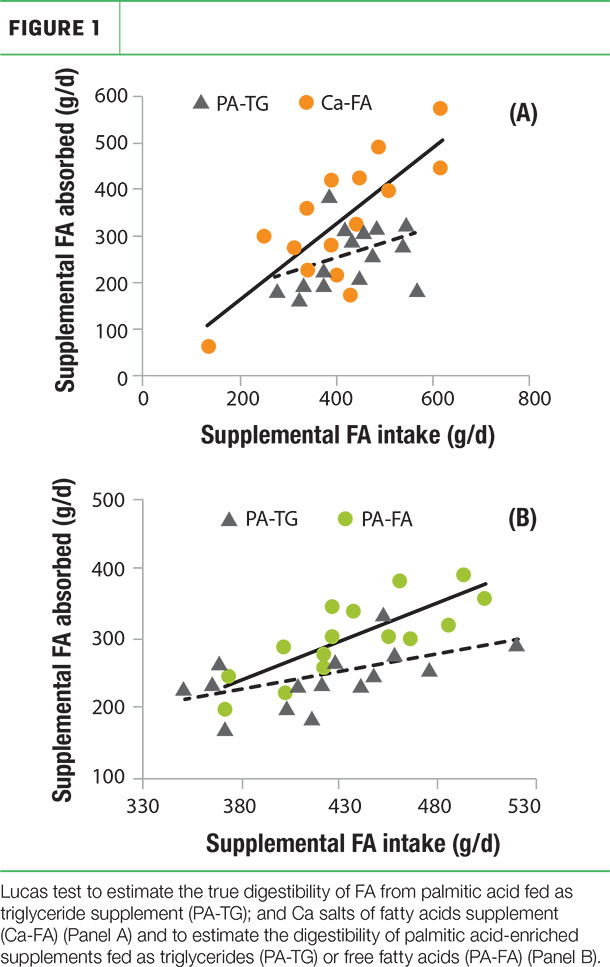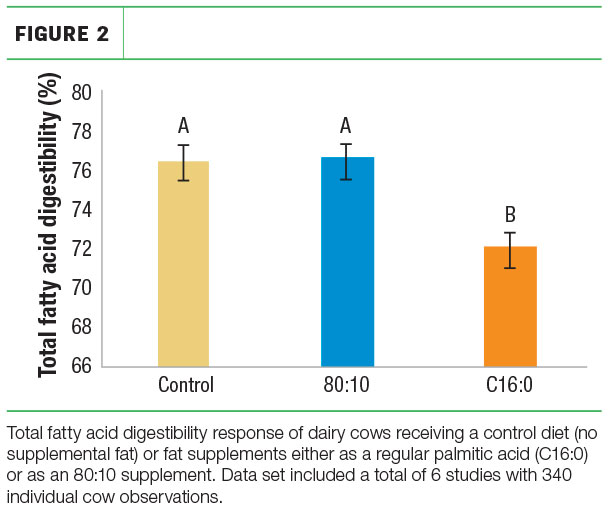Due to this increased interest in C16:0, several different supplements are now available in the market with different degrees of C16:0 enrichment, free FAs versus triglycerides form and, lately, in combination with other FAs. So how can we make an informed decision on how to choose a supplement?
Why looking at FA digestibility is important
Usually, FA digestibility decreases as the supply of FAs to the intestine increases. The flow of stearic acid (C18:0) has a critical impact on total FA digestibility; a decrease in total FA digestibility appears to be driven by the digestibility of C18:0 because of the pronounced negative relationship between the duodenal flow and digestibility of C18:0. Unsaturated FAs are reported as having greater digestibility than saturated FAs.
Oleic acid (cis-9 C18:1) appears to have important amphiphilic properties, which has a positive effect on the micellar solubility of C18:0. While total flow of FAs at the duodenum impacts FA digestibility, the profile of FAs entering the duodenum is a critical factor affecting FA digestibility.
Among the different options of C16:0 supplements in the market, we can broadly classify them in four categories:
- Regular C16:0 – pelletized free FA supplements containing approximately 85 percent of C16:0
- Highly enriched C16:0 – pelletized free FA supplements containing approximately 99 percent of C16:0 and only trace amounts of other FAs.
- C16:0 triacylglycerol (TAG) – supplements similar in profile to a regular C16:0 supplement but provided as triglycerides rather than free FAs
- 80:10 supplements – containing mainly C16:0 as free FA and mainly oleic acid as a calcium salt
The fatty acid profiles of these different commercial categories are presented in Table 1.

Digestibility of C16:0 TAG supplements
Under normal conditions, most FAs reaching the intestine of ruminants are free FAs, and therefore lipase activity is lower than in non-ruminants. Researchers in 2018 estimated the true digestibility of the fat supplements as 62 percent and 81 percent for a palmitic acid TAG supplement (PA-TG) and calcium salts of palm FA (Ca-FA), respectively (Figure 1, Panel A).

Similarly, researchers in 2019 compared, at the same FA feeding rate, a PA-TG with a regular free FA C16:0 supplement (PA-FA). They reported the estimated true digestibility of the fat supplements as 59 percent and 69 percent for a PA-TG and PA-FA, respectively (Figure 1, Panel B).
Therefore, the digestibility of C16:0 as TAG supplement is lower than both calcium salts of palm fatty acid distillate (PFAD) and PA-FAs. Because C16:0 TAG supplements are usually cheaper than a free FA supplement, it is important to take these factors into consideration because the response in milkfat yield is lower for a TAG supplement.
Digestibility of highly enriched C16:0 supplements
Among the palmitic acid-enriched FA supplements, those highly enriched in C16:0 (99 percent C16:0) have received limited published research. Researchers in 2013 fed 2 percent of a highly enriched C16:0 supplement and observed that total FA digestibility decreased by 10 percentage units (71.3 versus 61.2 percent for control and treatment diet, respectively).
Using the intake, and absorbed FAs from the control and treatment diet, we can estimate the digestibility of the supplement. Based on these calculations, the intake of the supplement was 551 grams per day, and the absorbed was 260 grams per day, resulting in a digestibility of the supplement of 47 percent. Evaluation of these highly enriched C16:0 supplements is a topic that deserves further research.
Digestibility of regular C16:0 and 80:10 supplements
Among the palmitic acid-enriched FA supplements, those containing around 85 percent of C16:0 as free FA are the most commonly used. Additionally, recent research suggested supplements containing a combination of palmitic and oleic acids (80 percent C16:0 and 10 percent cis-9 C18:1) increased production responses when compared with other FA supplements.
Therefore, is the FA digestibility of an 80:10 supplement different than that of a regular C16:0-enriched supplement?
To answer this question, we combined the FA digestibility of individual cow data (n = 340) from six studies that used an 80:10 supplement (two studies) or a regular C16:0-enriched supplement (four studies). Our results showed feeding a regular C16:0-enriched supplement decreases total FA digestibility by approximately four units (Figure 2).

In contrast, an 80:10 supplement did not affect total FA digestibility compared to that of control diets. It is postulated these results are due to a greater amount of oleic acid reaching the intestine, which acts as an emulsifier and improves digestibility. Additionally, oleic acid bound to a calcium salt will increase the likelihood of greater amount of oleic acid reaching the intestine versus the free oleic contained in a regular C16:0 supplement.
Implications and conclusions
Looking to FA absorption is not different from what has evolved over time with protein and amino acids. The same way we value amino acid profile of metabolizable protein (MP) over simple crude protein (CP), we should value absorbed FAs given our recent findings on the FA profile effects on digestibility and metabolic functions.
Based on the available literature, we can rank the digestibility of C16:0 supplements, as 80:10 is greater than regular C16:0, which is greater than C16:0 TAG and finally greater than highly enriched C16:0.
Predicted values of absorbed FAs in the Cornell net carbohydrate and protein system (CNCPS)-based models are misleading because the model assigns fixed digestibility values to individual FAs and does not consider other factors affecting digestibility. As pointed out in this review, physical factors and profile of the supplement are important in estimating the absorbed FAs from any supplement.
Evaluating the FA profile of a supplement is important but also can be misleading. The level of oleic acid seems to be important to achieve higher digestibility, but other physical factors are relevant.
When choosing a C16:0 supplement, the cost per unit (pounds, ton, etc.) is not the only factor to consider. Evaluating the FA profile, physical characteristics and, mainly, the digestibility of the supplement are imperative factors to consider in the decision. When calculating the cost of a C16:0 product, taking into consideration the digestibility value of the supplement will better represent the value of nutrients delivered to the cow. ![]()
References omitted but are available upon request. Click here to email an editor.

-
Jonas de Souza
- Product Manager
- Perdue AgriBusiness Animal Nutrition
- Email Jonas de Souza





